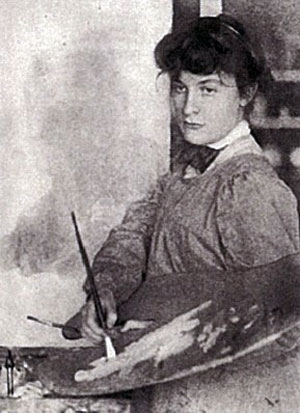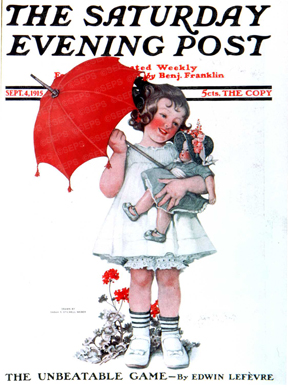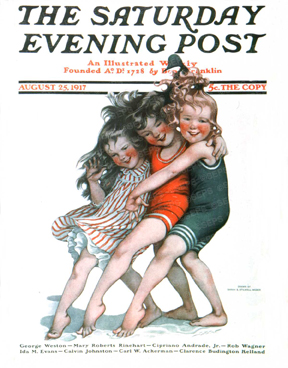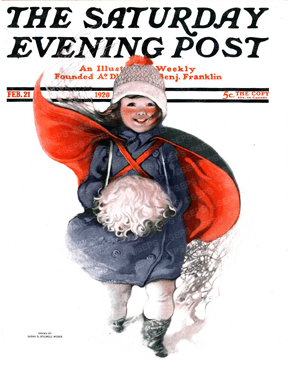Sarah Stilwell Weber

Sarah S. Stilwell was born in Concordville, Pennsylvania in 1878. Little is known about Sarah’s early life but her nieces and nephews describe her fondly. “My Aunt Sarah was a unique person with a great deal of imagination which is quite apparent in her work. She was a self-effacing yet positive woman who loved the innocence of little children.”
Sarah was fortunate to attend the Drexel Institute in Philadelphia in 1897, around the time that Howard Pyle was coming on as a full time teacher. Pyle was a well- known illustrationist in his own right, and was known for the innovations that he brought to the field of illustrating. Pyle’s classes quickly became popular, making it difficult to gain entry without strong credentials and fierce determination. In a letter to his friend Edward Penfield, the art editor of Harper’s Bazaar, Pyle wrote:
“I shall make it a requisite that the pupils whom I choose shall possess—first of all, imagination; secondly, artistic ability; thirdly, color and drawing; and I shall probably not accept any who are deficient in any one of these three requisites.”
In the summer of 1899, Sarah-Stilwell was invited to join an exclusive group of students at Chadd’s Ford on the Brandywine. Drexel Institute had managed to raise a thousand dollars for Pyle to fund this special project, with ten one-hundred-dollar scholarships being awarded to only his most talented students. Sarah joined this exclusive group of the best and the brightest in the freedom from the tyranny of conventional and restrictive methods of teaching. They dined, worked and played together, creating a sense of comradery and openness rather than harsh competition. Sarah’s time in this relaxed atmosphere would remain a theme she would foster in the years to come. At the close of Sarah’s first summer session, Pyle’s report read:
“All the students have shown more advance in two months of summer study than they have in a year of ordinary instruction. This, of course, might have been largely due to the fact of the contact of the students with nature and of their free and wholesome life in the open air. They prepared for work at eight o’clock in the morning and they rarely concluded their labors until five or six in the afternoon.”
What Howard Pyle did for his most prized students was literally to launch their career in the New York marketplace. He not only showed them how to improve and refine their talent but he went a step further by introducing them to the market in which their talent could produce a livelihood. And Sarah Stilwell was one of Pyle’s favorite young artist. At the turn of the century, Sarah was one of the first students to move into his Wilmington, Delaware studio at 1305 Franklin Street. There, along with other fine artists as Ethel Franklin Betts, Dorothy Warren, Frank Schoonover, Stanley Arthurs and others, she worked and shared knowledge. Howard Pyle urged Sarah never to marry, as marriage would interfere with the creative life of the artist.
Covers by Sarah Stilwell Weber
Girl with Parasol and Doll
Sarah Stilwell-Weber
September 4, 1915
Three Little Girls at Beach by Sarah Stilwell-Weber
Sarah Stilwell-Weber
August 25, 1917
Girl in Snow
Sarah Stilwell-Weber
February 21, 1920
Sarah did the majority of her cover art for The Saturday Evening Post from 1904 through 1921. Not one to work well under pressure, she resisted the offer by George Horace Lorimer to do regularly scheduled pieces. She preferred having the freedom to work at her own pace and submit items at her leisure, feeling that a deadline might compromise her need to work until she felt personally satisfied with the result. Many of the Brandywine School artists had a flair for capturing grace and detail of the Victorian Era yet not letting decoration and detail overwhelm the subject matter. Sarah was particularly adept at creating movement and flow that gave the impression of coming and going. Her work was not merely a snapshot captured at a point in time. You had the distinct impression that the subject would dance off the page in the next moment.
Sarah Stilwell-Weber’s illustrations graced sixty covers of The Saturday Evening Post and five for The Country Gentleman. Her favorite subjects were of young children while at play, taking you back to a time of simple pleasures. Their youthful enthusiasm and all the movement that goes with their exploration are captured in the expressions on their delight filled faces.
One of Sarah Stilwell-Weber’s last publishing ventures was a children’s book entitled The Musical Tree. Her husband, Herbert, wrote the poems and music, Sarah did the illustrations. She died on April 6, 1939 at her home in Philadelphia, Pennsylvania at the age of sixty-one.


